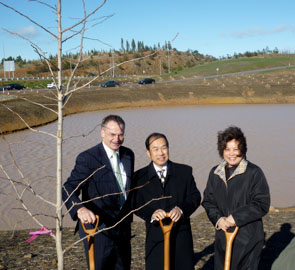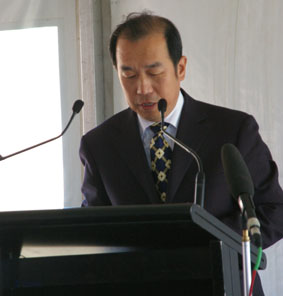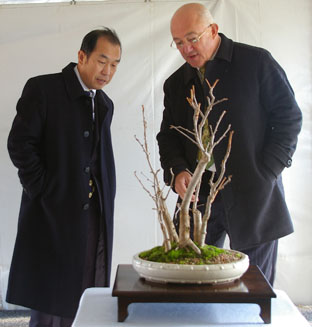Ancient trees for new Arboretum Forest
Mr Jon Stanhope, Chief Minister of the ACT, His Excellency Mr ZHANG Junsai, Ambassador of the People's Republic of China, and his wife Madam YIN Guomei planted three Ginkgo biloba trees at the National Arboretum Canberra on Wednesday 10 June 2009.
Ambassadors and High Commissioners, business and community leaders and China-Australia friendship groups braved the winter chill at the Arboretum to witness the tree-planting ceremony.

From left to right: Mr Jon Stanhope, Chief Minister of the ACT;
His Excellency Mr ZHANG Junsai, Ambassador of the People's Republic of China; Madam YIN Guomei.
To celebrate the sister city relationship of the capitals of Beijing, China's ancient capital and Canberra, the Ginkgo biloba (Maidenhair Tree) forest was assigned a prominent location in what will soon become the central valley of the Arboretum.


The Ginkgo biloba with its handsome Maidenhair foliage and brilliant yellow autumn cover is an iconic Chinese specimen which is also listed as endangered.
It has taken several years to source the seeds, raise the seedlings and establish this massive forest. A total of 1624 Ginkgo biloba will be planted by 2010, arranged corresponding with the site plan of the Forbidden City in Beijing. This is a significant accomplishment - one of the largest and most stunning forests at the Arboretum - completed as Canberra and Beijing celebrate the 10th anniversary of our sister city relationship next year.
The ginkgo species are a group of plants which first appeared in the Jurassic period, about 200 million years ago. Several genera are known in the fossil record, but only a single species of one genus - the Ginkgo biloba - is present today. It is the sole survivor.
The Ginkgo biloba's aristocratic character is defined by it statuesque shape and distinctive yellow autumn foliage. Heritage registers document the many wonderful trees that grow among the grounds of temples, shrines and palaces in China. A deciduous conifer, the Ginkgo biloba prefers a temperate climate and occurs naturally in the south east of China. There are said to be some wild populations on Xitianmu Mountain, in Zhejiang province.
Ginkgo biloba adorn Canberra suburbs from Belconnen to Tuggeranong. The oldest known surviving ginkgo in Canberra is a female tree, one of a pair planted in 1953 in the Quadrangle of University House. Another splendid tree, about 15m tall is a male ginkgo in the grounds of Hobday's Cottage in the English Garden at Yarralumla.
In time the Ginkgo biloba trees planted at the Arboretum will mature and reveal their gender. In approximately 20-30 years the female trees will bear small golden fruit which have a pungent odour. In Chinese medicine Ginkgo fruit are considered to have potent medicinal value.

His Excellency Mr ZHANG Junsai, Ambassador of the People's Republic of China and Mr John Mackay,
chair of the Arboretum Board of Governors discuss the Penjing forest of Ginkgo biloba.
